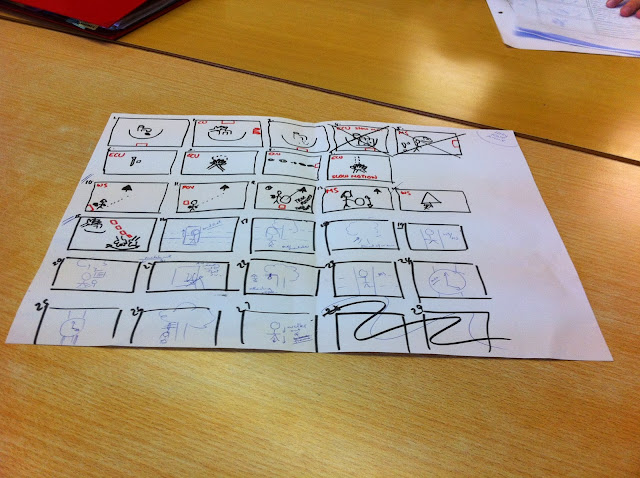Thriller Sub-Genres
There are many different sub-genres of thrillers:
CONSPIRACY THRILLERS:
 The general idea for a conspiracy thriller involves the protagonist finding something that unravels a vast conspiracy. Often the protagonist has difficulty exposing the conspiracy as little believe them and rumours, lies and propaganda work against them. However, a general theme in conspiracy thrillers is that the 'bad' people cause the tragic events and the 'good' people fight against them and defeat them.
The general idea for a conspiracy thriller involves the protagonist finding something that unravels a vast conspiracy. Often the protagonist has difficulty exposing the conspiracy as little believe them and rumours, lies and propaganda work against them. However, a general theme in conspiracy thrillers is that the 'bad' people cause the tragic events and the 'good' people fight against them and defeat them.
Example:
The Da Vinci Code - directed by Rod Howard
A murder inside the Louvre and clues in Da Vinci paintings lead to the discovery of a religious mystery which has been preserved by a secret society for two thousand years and when discovered could shake the foundations of Christianity.
POLITICAL THRILLERS:
A political thriller is set against the backdrop of a political struggle, that often contains themes of government corruption, warfare and terrorism. Normally, the political power in control have ulterior motives and often try to gain control of everything in a total fascist regime. A political thriller can be based on true events or be fiction.
Example:
Mississippi Burning - directed by Alan Parker
Two FBI agents, with completely different styles arrive in Mississippi to investigate the disappearance of three civil right activists. The film explores the racism that dominated the south of America during the 20th century, and the plea for the government to do something to help the Black community.
SPY THRILLERS:
 Spy thrillers explores the subject of fictional espionage, either in a realistic way or as the basis of fantasy. The main ideal is that a government agent has to discover the secrets of their enemies without being caught. The spy film combines the genres of action and thriller.
Spy thrillers explores the subject of fictional espionage, either in a realistic way or as the basis of fantasy. The main ideal is that a government agent has to discover the secrets of their enemies without being caught. The spy film combines the genres of action and thriller.
Example:
Tinker Tailor Soldier Spy - directed Tomas Alfredson
In the dangerous days of the Cold War, espionage veteran George Smiley is forced from his semi retirement in order to uncover a Soviet agent working within M16.
PSYCHOLOGICAL THRILLER:
 This is a very broad sub-genre of thrillers. Its focus is on the emotional and mental and instability of the characters with a mysterious element as well. Suspense in psychological thrillers is often created when two characters play on each others minds, usually by the way of deceptive games or trying to cripple the others mental state. Psychological thrillers often combine with horror genre as some of the elements within them are similar. For example, often the characters lives end in a gruesome way rather than justice being served.
This is a very broad sub-genre of thrillers. Its focus is on the emotional and mental and instability of the characters with a mysterious element as well. Suspense in psychological thrillers is often created when two characters play on each others minds, usually by the way of deceptive games or trying to cripple the others mental state. Psychological thrillers often combine with horror genre as some of the elements within them are similar. For example, often the characters lives end in a gruesome way rather than justice being served.
Example:
Black Swan - directed by Darren Aronofsky
A ballet dancer wins the role of a lifetime in the show "Swan Lake", and is perfect for the role of the delicate white swan. However, she progressively begins to lose her mind as the show beings to take its toll on her mental health and she becomes more and more like the black swan.
TECHNO THRILLERS:
A techno-thriller is hard to define as it blurs with many other genres. Often it combines with science fiction so that the main theme is on plausible near-future technology and how this effects the world. Also world wars are a common topic with focuses being on military and political actions, so combines with conspiracy and political thrillers.
Example:
Minority Report - directed by Steven Spielberg
This film is set in the future where a special unit of the police force are able to see crimes that are about to happen, thus arrest people before they commit their crimes. An officer from that unit then sees himself committing a murder in the future.
SUPERNATURAL THRILLERS:
A supernatural thriller brings ideas of otherworldly elements into the plot as well as building suspense and tension. Supernatural thrillers can focus on ghosts, the occult and sometimes the main character has the ability to talk or see the dead. These films deal less with action, but instead focus on building tension with a series of plot twists.
Example:
The Sixth Sense - directed by M. Night Shyamalan
A boy who has the ability to see and talk to dead people seeks the help of a disheartened child psychologist who does not really that he is in fact dead himself.







